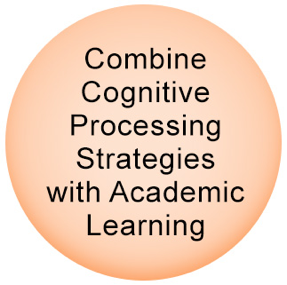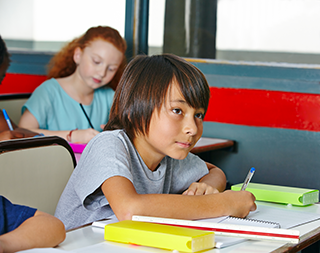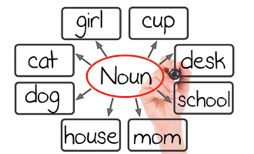How can school personnel intensify and individualize instruction?
Page 6: Teach Cognitive Processing Strategies
 Although using the least-intensive methods to adapt instruction—that is, changing dosage and time, and changing the learning environment—might result in improved performance for some students, for others it might not prove so effective. Some students struggle, despite their hard work and effort, because they have deficits in executive functions, the cognitive processes that control and coordinate activities related to learning. These activities include:
Although using the least-intensive methods to adapt instruction—that is, changing dosage and time, and changing the learning environment—might result in improved performance for some students, for others it might not prove so effective. Some students struggle, despite their hard work and effort, because they have deficits in executive functions, the cognitive processes that control and coordinate activities related to learning. These activities include:
- Processing information
- Retaining and recalling information
- Organizing materials and managing time
- Selecting, monitoring, and using effective strategies
For students with executive function deficits, the teacher might need to make a qualitative change, such as teaching cognitive processing strategies in addition to the intervention. In other words, teachers need to instruct students about how to strategically approach academic tasks to gain and use information effectively. These cognitive processing strategies can address deficits in:
- Memory
- Self-regulation
- Attribution
Memory
Signs of Poor Memory
A student with poor memory might:
- Often forget steps in a multi-step process
- Require new material to be presented multiple times
- Forget previously taught information
Students with poor memory often have difficulty with complex tasks such as following multi-step directions, writing an essay, solving complicated mathematics problems, or remembering what they just read. When a student’s memory is overloaded, he or she struggles to process new information as well as to retain and recall information previously learned. Instructors can explicitly teach students a number of strategies (a few of which are described below) to help them address memory deficits. To be effective, these strategies should be integrated into the intervention.
 Note-taking is an effective way for students to retain and recall information. It helps students to:
Note-taking is an effective way for students to retain and recall information. It helps students to:
- Understand the information they read or that is presented during a lecture (i.e., improved comprehension)
- Organize and process important information
- Actively engage with the material
- Put the information into their own words
 Graphic organizers, sometimes called word webs or concept maps, can help students:
Graphic organizers, sometimes called word webs or concept maps, can help students:
- Organize information
- See relationships between ideas
- More easily understand, remember, and apply information
 Mnemonic strategies use visual or auditory clues to help students:
Mnemonic strategies use visual or auditory clues to help students:
- Make connections between their own prior knowledge and new information
- Retain and recall information
For example, the image to the right can be used to help students remember that “scow” means “a large flat-bottomed boat with broad square ends used chiefly for transporting sand, gravel, or refuse.” When presented with “scow,” students think of the keyword “cow.” Next, they remember the picture of the cow sitting in the boat filled with sand. This helps them remember the definition of “scow.”
 In verbal rehearsal, students repeat instructional content over and over again. This strategy helps them to commit the information to memory.
In verbal rehearsal, students repeat instructional content over and over again. This strategy helps them to commit the information to memory.
In addition to teaching students memory strategies, teachers can help students learn information by using one or more of the following instructional strategies.
- Using multiple modalities to present information (e.g., verbal description, illustration, manipulatives)
- Modeling procedures
- Repeating important information
- Reviewing steps or procedures
- Reviewing previously learned content
- Monitoring student understanding frequently
Self-Regulation
Signs of Poor Self-Regulation Skills
Students with poor self-regulation skills might display:
- Difficulty monitoring and regulating their own behavior or learning
- Frequent inattention
- Frequent impulsiveness
Many students with severe and persistent learning difficulties have not learned how to control their thinking or behavior. To be successful, students must assume responsibility for their own learning. They can do so by learning self-regulation strategies. Self-regulation is the ability to select, monitor, and use appropriate strategies. Four major types of self-regulation strategies teachers can explicitly teach and embed within instruction are described below.
Definition: Keeping track of one’s progress and recording the results This strategy:
- Provides more immediate feedback to students than is possible when teachers evaluate the behavior
- Clearly depicts improvement over time
- Engages students
- Increases students’ awareness of their own behavior
Definition: Talking oneself through a task or activity (also known as self-talk)
Students can create encouraging or guiding statements for different types of situations, such as:
- Checking answers (“Does the answer I came up with make sense?“)
- Starting or working through a task or problem (“What do I need to do to solve this problem? I need to use the formula d=rt. First, I should…“)
- Check for understanding (“I just read a passage. Do I understand what it said?“)
- Controlling impulsive behavior (“I really want to tell my friends about my weekend. But now is not the time. I should wait until we finish the lesson.“)
Definition: Establishing achievable objectives for learning
Goal-setting helps students to understand what they are striving for. It can increase student attention, motivation, and effort. For students who struggle with completing tasks on time, the best goals might be those that can be accomplished fairly quickly (i.e., short-term goals). When setting a goal, students should:
- Identify appropriate goals (one that is not too easy or too difficult; one that is specific enough to measure)
- Develop plans for meeting goals and monitor progress toward those goals
- Implement the plans
- Self-monitor progress toward meeting the goal
- Revise the goals when needed
Definition: Rewarding oneself after completing a task
After completing a task or achieving a goal, students can reward themselves with reinforcers that are:
- Tangible (e.g., ice cream)
- Social (e.g., a night out with friends)
- Activity-related (e.g., watching TV)
Listen as Don Deshler discusses the importance of teaching students self-regulation strategies (time: 1:11).
Don Deshler, PhD
Professor, Special Education
Director, Center for Research on Learning
University of Kansas

Transcript: Don Deshler, PhD
If we’re not successful in helping students become self-regulated learners, ultimately they’re going to fail because we can’t be with them at all times, and the demands of the situation that they’re facing is going to continually change. And they need to be able to change with it and to regulate how they’re learning in light of these new demands that they’re coming across. So that’s a part of the instructional process. It’s not just teaching them a specific strategy: Here are the steps of the strategy. Now let’s practice it. Now let’s apply it. No, it’s also having ongoing conversations with them about what good learning looks like, what it feels like, what failure feels like, and how you deal with failure and how you back up, do some self-talking, self-regulation, how you seek out some assistance within your environment, and so forth so that you can go at it again and be successful.
Attribution
Many students with persistent and severe learning difficulties attribute their poor performance to internal causes over which they have no control (e.g., lack of intelligence, ADHD). Conversely, they attribute successful performance to external causes (e.g., an easy test). Teachers can help students learn that they do have control over their performance by:
- Teaching them strategies, such as self-talk, to counter negative thinking
- Encouraging them to set goals and to monitor their own performance using a visual representation (e.g., graph, chart)
- Providing explicit feedback to connect their efforts to their successful outcomes